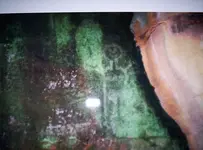This excerpt is from a history of the Omaha Tribe.
So great were the requirements demanded of a man for admission
to the Ho n/ hewachi that the successful candidate was said to have
been "pitied" (compassionately helped) "by Night," as otherwise he
could not have accomplished the tasks required. The symbols tat
tooed on the girl were designated xthexe, an untranslatable name
meaning a mark of honor or of distinction. It will be remem
bered that the Sacred Pole (see p. 219) was called Waxihe xe, signi
fying "that which has the power to bestow honor or distinction."
The Sacred Pole, as its name implies, was representative of the
authority which was the fount of honor in the tribe. Permission to
place this mark of honor on a girl had to be given by the Seven
Chiefs, as well as by the members of the Ho n/ hewachi. The Ho n he-
wachi is claimed to be very old and in connection with this claim it
should be remembered that the ancient name of the Cedar Pole (see
p. 219) was Waxthe xe, and that the name of this ancient and sacred
object, w r hose ceremonies had become lost, was transferred to the
new Sacred Pole when the latter emblem was set up in the interests
of tribal unity and stability of government. The ancient pole
of cedar, according to tradition and myth, was allied to ceremonies
connected with Thunder and with the creation of the human race.
It was kept, as was the Sacred Shell, in the Sacred Tent in charge
of the We zhi n shte gens. According to traditions and beliefs, the
rites pertaining to the Shell were connected with the cosmic forces
which brought the universe into being and maintained its life.
While it is impossible clearly to trace connection between the Ho n/ he-
wachi and the ceremonies that once clustered about the ancient Cedar
Pole and the Sacred Shell, yet the name given to the mark of honor,
(xthexe), the symbols used, and the sex of the person on whom they
must be tattooed, as well as the name of the society to which they
belonged, all afford a strong probability that the ancient cosmic
rites, long since lost, were related to the Ho n/ hewachi, if they do not
in part survive in the ceremonies of this society, ceremonies which
FLETCHER-LA l- LKSCHE] SOCIETIES 495
in songs and symbols refer to the creative cosmic forces typified by
night and day, the earth and the sky, forces which were also repre
sented in the fundamental ideas on which the tribal organization
rested.





